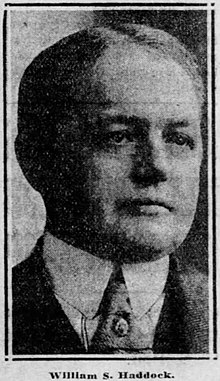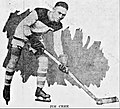
The Allan Cup is the trophy awarded annually to the national senior amateur men's ice hockey champions of Canada. It was donated by Sir Montagu Allan of Ravenscrag, Montreal, and has been competed for since 1909. The current champions are the Lacombe Generals, who captured the 2019 Allan Cup in Lacombe, Alberta.
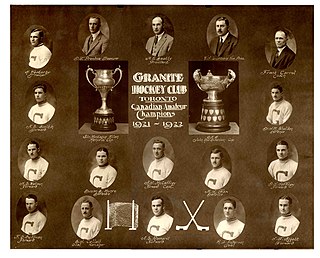
The Toronto Granites were an amateur senior ice hockey team from Toronto, Ontario. The Granites were Allan Cup champions in 1922 and 1923. They were chosen to represent Canada at the 1924 Winter Olympics in Chamonix, France. The Granites won the second consecutive Olympic gold medal for the Canada national men's ice hockey team.

Sigurður Franklin Fredrickson was a Canadian ice hockey player and coach who was significant to both the amateur and professional sport as it evolved in North America in the early 20th century. Fredrickson's career was interrupted by military service during the First World War and prematurely ended by a knee injury in 1931.
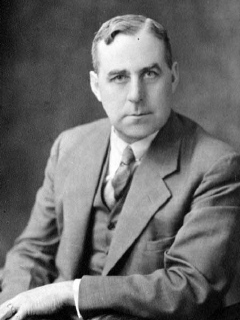
William Raymond "Toby" Sexsmith was a Canadian politician and ice hockey administrator. He was elected three times as a Progressive Conservative Party member of the Legislative Assembly of Manitoba representing the Portage la Prairie riding from 1933 to 1943. He served as president of the Manitoba Amateur Hockey Association from 1921 to 1923 and sat on the association's executive committee for 25 years. He served as president of the Canadian Amateur Hockey Association (CAHA) from 1922 to 1924 and set a precedent that future CAHA presidents would also be given two-year terms.

The Canadian Amateur Hockey Association was the national governing body of amateur ice hockey in Canada from 1914 until 1994, when it merged with Hockey Canada. Its jurisdiction included senior ice hockey leagues and the Allan Cup, junior ice hockey leagues and the Memorial Cup, amateur minor ice hockey leagues in Canada, and choosing the representative of the Canada men's national ice hockey team.

William Abraham Hewitt was a Canadian sports executive and journalist, also widely known as Billy Hewitt. He was secretary of the Ontario Hockey Association (OHA) from 1903 to 1966, and sports editor of the Toronto Daily Star from 1900 to 1931. He used the newspaper to promote the establishment of the Canadian Amateur Hockey Association (CAHA), served as its secretary-treasurer from 1915 to 1919, and was a trustee of the Allan Cup and the Memorial Cup. Hewitt served as the CAHA's registrar from 1921 to 1925, was the registrar-treasurer from 1925 to 1961, and implemented standard registration and transfer forms. He was a committee member to discuss professional-amateur agreements with the National Hockey League, and negotiated working agreements with amateur hockey governing bodies in the United States. He oversaw referees within the OHA, and negotiated to have common rules of play for amateur and professional leagues as chairman of the CAHA rules committee. After retiring from journalism, he was the managing-director of Maple Leaf Gardens from 1931 to 1948, and chairman of the committee to select the inaugural members of the Hockey Hall of Fame in 1945.
Pittsburgh Yellow Jackets was the name of three separate ice hockey teams based in Pittsburgh, Pennsylvania. The original team was part of the United States Amateur Hockey Association (USAHA) from 1920 to 1925 and developed from predecessors dating back to 1915. They evolved from being an amateur to a semi-pro team and are one of the earliest sports organizations in Pittsburgh, Pennsylvania. After winning the USAHA Championship in 1924 and 1925, the Yellow Jackets were sold to attorney James Callahan and soon became the Pittsburgh Pirates of the National Hockey League. However, after the demise of the Pirates in 1930, a second Yellow Jackets club played for two seasons in the International Hockey League, a minor professional circuit. A third team of the same name was organized at the amateur level in 1935 by John H. Harris and competed in the Eastern Amateur Hockey League before folding in 1937.
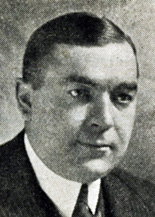
Roy Dunlap Schooley was a former hockey referee who later became the manager of both Duquesne Gardens, located in Pittsburgh, Pennsylvania, and the Pittsburgh Yellow Jackets of the United States Amateur Hockey Association. In 1925, the Yellow Jackets hockey club, evolved into the Pittsburgh Pirates of the National Hockey League. On March 16, 1920 at the Duquesne Gardens, he helped found USA Hockey, the governing body for amateur ice hockey in the United States. That same year, he assembled the first U.S. Olympic Hockey Team which won a silver medal at the 1920 Summer Olympics in Antwerp, Belgium and is credited with helping to foster the growth of hockey in the country.
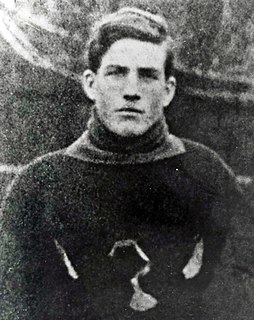
Sylvester Patrick "Silver" Quilty was a Canadian football player, referee, coach and sport administrator. As a player, he won the Yates Cup in 1907 with the Ottawa Gee-Gees football team, and was credited as the first man to play the flying wing position. He also played with the Ottawa Rough Riders, and the McGill Redmen football team. After his playing career, he became a football referee and officiated the 10th Grey Cup, and also coached the Ottawa Rough Riders.
The Fort Pitt Hornets were a semi-professional ice hockey team based in Pittsburgh, Pennsylvania. The team played in the United States Amateur Hockey Association (USAHA), which was technically a semi-pro league by 1924.

William Alexander Fry was a Canadian sports administrator and newspaper publisher. Fry founded the Dunnville Chronicle in 1896, managed local hockey and baseball teams in the 1910s, then served as president of the Ontario Hockey Association (OHA) from 1922 to 1924. At the national level, he was president of the Canadian Amateur Hockey Association (CAHA) from 1928 to 1930, was a Canadian Olympic Committee member and British Empire Games committee member from 1927 to 1938, and served as president of the Amateur Athletic Union of Canada from 1934 to 1936.

Frank Ernest Sandercock was a Canadian ice hockey administrator. He served as president of both the Canadian Amateur Hockey Association and the Alberta Amateur Hockey Association, and had previously been an executive with the Ontario Hockey Association and founded a hockey organization to operate leagues in Calgary. He was an early proponent of junior ice hockey and senior ice hockey in Alberta, fostered growth in the game, and sought to reinvest profits into minor ice hockey for the younger generation.

John Franklin Paxton was a Canadian ice hockey administrator. He served as president of the Ontario Hockey Association (OHA) and also acted as president of the Canadian Amateur Hockey Association during World War I. He ensured that competition for the Allan Cup continued, which saw increased participation from military teams playing senior ice hockey in Canada. He partnered with W. A. Hewitt to negotiate a relationship with the International Skating Union of America to resume hockey games between Canada and the United States that had ended due to the war. Paxton later served as treasurer of the OHA, was a regular delegate to the general meetings of the Amateur Athletic Union of Canada, and represented the old guard of strict principles of amateurism where hockey players did not accept money. After his death, the Winnipeg Free Press referred to Paxton as both "Canada's most beloved hockey official", and "hockey's most beloved figure".

Frank Chapin Greenleaf was a Canadian sports administrator. He served as president of the Canadian Amateur Hockey Association and the Quebec Amateur Hockey Association, and was an executive in the Quebec branch of the Amateur Athletic Union of Canada. He presided over amateur hockey when the Canadian Amateur Hockey Association wanted to end the raiding of its rosters by foreign teams and to prevent a geographic shift in talent by imposing a residency rule for players. Greenleaf negotiated for a North American senior ice hockey championship that saw the Allan Cup winner play the amateur champion of the United States. He served as an executive member of multiple amateur hockey leagues in Montreal and was one of the founders of the Mount Royal Junior Hockey League.

William Rowen Granger was a Canadian sports administrator and businessman. He served as president of the Montreal AAA from 1918 to 1920, oversaw the revival of the association's ice hockey, baseball and soccer teams after World War I, and previously served as president of the Montreal Lawn Bowling Club and the Montreal Bicycle Club. He helped establish the Province of Quebec Lawn Bowling Association and became its president in 1919. He also served as president of the Inter-Club Road Race Association of Montreal, helped organize the Cyclists' Rights Committee in Montreal, and was a director of the Canadian Wheelmen's Association. He was instrumental in founding the Quebec Amateur Hockey Association (QAHA) in 1919, and became its second president. He was committed to amateurism in sport, sought to rid hockey of veiled professionalism, and implemented standard rules of play and registration cards with the Amateur Athletic Union of Canada. Granger and the QAHA were defendants in a court case that challenged the denial of an amateur registration card to a player who participated in semi-professional baseball prior to reaching the age of majority. The case necessitated constitutional changes to the strengthen the QAHA's authority and that registration forms be printed in both English and French.
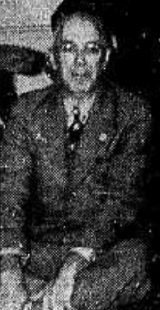
Harry John Sterling was a Canadian ice hockey administrator. He was elected president of the Canadian Amateur Hockey Association (CAHA) in 1920, after serving as an Ontario Hockey Association executive and as president of the Thunder Bay Amateur Hockey Association. He declared that the CAHA would not tolerate the hockey "tourist" after becoming suspicious of players who changed their addresses to be on a new team. His investigation into registrations led to the suspension of a team from Saskatoon when it was discovered that players who won the gold medal representing Canada in ice hockey at the 1920 Summer Olympics were being paid for amateur hockey. His term as president resulted in the CAHA enacting stricter rules for registration and co-operation with the Amateur Athletic Union of Canada to investigate into all Canadian hockey players to maintain amateurism.

Frederick Everett Betts was a Canadian ice hockey administrator and businessman. He concurrently served as president of the Canadian Amateur Hockey Association (CAHA), the Saskatchewan Amateur Hockey Association, and the Saskatchewan branch of the Amateur Athletic Union of Canada during the 1919–20 season. He sought regulations to govern amateur sport in Canada, which he felt was in a state of disrepute due to the lack of discussion and the postponement of meetings during World War I. He supported the reinstatement of former professionals as amateur athletes as favoured in Western Canada, despite the growing rift with delegates from Eastern Canada on the issue. He sought for the Allan Cup trustees to allow the CAHA to have more say into how the national playoffs were operated and argued for receiving an annual percentage of profits from gate receipts to allow the CAHA to govern effectively.

Frederick Paul Henry Marples was a Canadian sports executive in ice hockey and athletics. He was president of the Winnipeg Monarchs team which won Winnipeg Amateur Hockey League championships in 1914 and 1915, and the Allan Cup as senior ice hockey champions of Canada. His operation of a reserve team to support the Monarchs led to debates on player eligibility for the Allan Cup and calls for a national governing body of hockey. As the secretary-treasurer of the Winnipeg Amateur Hockey League, he helped establish both the Manitoba Amateur Hockey Association (MAHA) and the Canadian Amateur Hockey Association (CAHA) in 1914; then served as secretary-treasurer of the MAHA from 1914 to until 1934, and as secretary of the CAHA from 1926 to 1945. He sought to grow the game in rural regions of Manitoba, promote minor ice hockey as a source of future senior players, to keep players in junior ice hockey until age 21, and was against the exodus of amateur players to professional teams.

The Cleveland Athletic Club ice hockey team was an amateur ice hockey team from Cleveland, Ohio operating during the first three decades of the 20th century out of the Cleveland Athletic Club. When the team joined the United States Amateur Hockey Association for the 1920–21 season it was known as the Cleveland Indians or Cleveland Hockey Club, and in 1924–25 as the Cleveland Blues.

The Eveleth Rangers were an amateur ice hockey team from Eveleth, Minnesota that played in various amateur leagues during the first half of the 1900s. As a member of the United States Amateur Hockey Association (1920–1925) the team was known as the Eveleth Reds, and in 1925–26 they played as the Eveleth-Hibbing Rangers in the CAHL, out of the Hibbing Memorial Arena in Hibbing, Minnesota.

